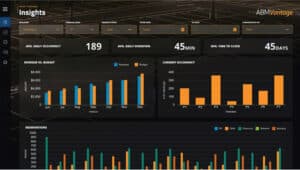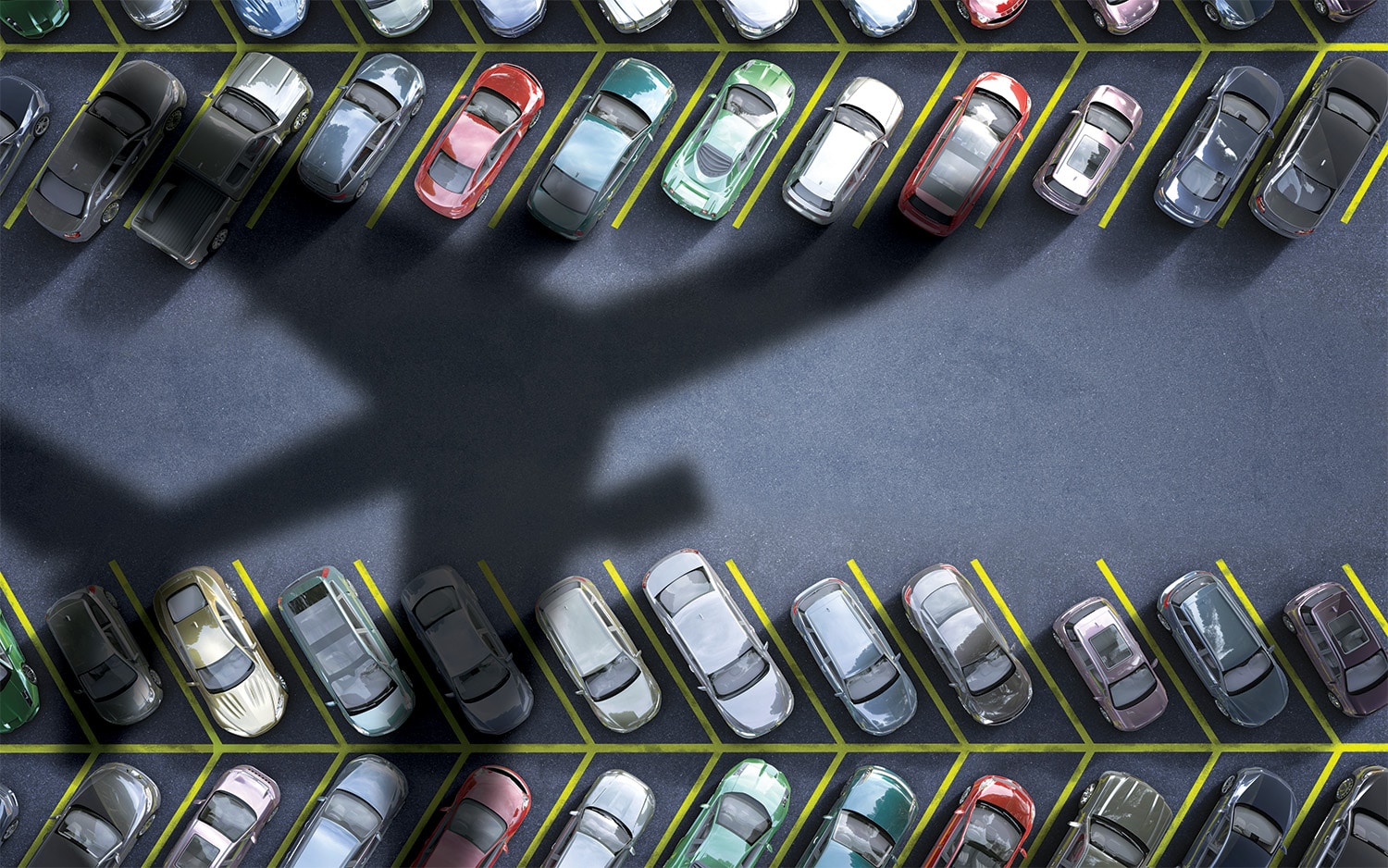
What innovation will have the most significant impact on parking and mobility in the next five years?
Innovations in AI, IoT, and 5G are set to revolutionize
Share:
Share:
Technology has undoubtedly made air travel easier. Previously, an airport terminal that was designed to process one million annual enplaned passengers needed a ticket lobby that could process one million passengers per year. Now, that same ticket lobby can handle four to five million passengers annually. These types of efficiencies have not always translated outside of the terminal. In many major airports, the passenger bottleneck has moved from the airport’s interior to the airport’s front door. Highways, access roads, and curbsides designed for a one-million-passenger airport have become gridlocked by increased traffic. This is only compounded during airport construction and new infrastructure projects.
Shortages and poor management of curb space also increase emissions due to vehicles searching for parking and can create unsafe conditions from vehicles double parking.
The good news is that very congested curbside pick-up and drop-off areas can offer a dramatic increase in curbside real-estate value. Let’s look at some strategies and technologies that can help improve land-side operations, increase airport revenue, and provide an enhanced passenger journey.
Transportation network companies (TNCs) such as Uber and Lyft have rapidly changed the ground transportation landscape at major airports. TNCs, taxis, vans, and buses are all vying to pick up and drop off travelers, all while dodging each other at the curb.
This not only negatively impacts the passenger experience, but it can cut into overall profits. According to the Airport Cooperative Research Program (ACRP), although many airports receive significant revenue from TNCs, others have recorded declines in other ground transportation modes such as parking revenue and rental car transactions. This has led to a push toward enhanced compliance with TNC activity and fee collection. Several airports have implemented access fees for TNC pick up and drop-offs. Los Angeles International Airport (LAX), began charging for TNC rides in 2016, which added nearly $9 million in revenue, while rental car revenue on a per enplanement basis fell by nearly 12% in the same year.
A geofence zone around the airport terminal access roads can accurately capture TNC use and charge the companies a fee for each drop-off or pick-up trip. The latest geofencing technology, in combination with operations software, can provide better tracking and monitoring for revenue collection, rule enforcement, and analytics to shed light on traffic patterns.
Prompted by heavy traffic caused by vehicles dropping off and picking up passengers during peak travel times, Tampa International Airport (TPA) overhauled its curbside operations by implementing 16 new express curbsides tailored to passengers without checked luggage. Departing guests will take an escalator or elevator straight to the transfer level, then hop on a shuttle to the airside. Passengers without a boarding pass can print one along the way at conveniently located kiosks. Arriving travelers will be able to quickly access ground transportation without interacting with baggage claim activity.
Washington Dulles International Airport (IAD) debuted what it calls the third curb, an area dedicated solely to TNC pickups. The new system is designed not only to relieve congestion but to make it easier for passengers using app-based ride services to connect with their drivers. The new TNC curb stretches almost 500 linear feet and includes a steel canopy to protect passengers from inclement weather while they wait, and to help redistribute vehicle volume.
Making the most out of usable curbside real estate may mean relocating some activities to remote areas. In fact, remote drop-offs may become the norm for passengers at many airports, with curbside access treated as a premium paid product. Airports can then use branding and pricing signals to differentiate between high-value curbside areas, near-terminal pickup/drop-off areas, and remote pickup/drop-off areas with shuttle bus services to terminals.
Supplemental areas such as cell phone waiting lots and free short-term parking near the terminal can shorten vehicle dwell time in passenger pick-up zones. Cars coming to pick up passengers wait at a distance from the main airport until their party has disembarked and picked up bags. The traveler texts or calls when ready for pick-up. While this service is usually free, it means cars do not wait at the curbside. However, these lots can compete with on-airport short-term parking, so there are revenue trade-offs that need to be evaluated.
During the height of its terminal re-development construction, LAX lost 30% of the inner-lane curb space that is currently used for passenger pickup and drop-off. In response, the airport “LAX-it,” a centralized area for guests to pick up a taxi or ride app service, and avoid traffic in the Central Terminal Area (CTA).
Remote baggage check-in is also gaining popularity. Harry Reid International Airport (LAS) was the first to introduce off-airport baggage drop in May 2006. Travelers can drop off their bags at one of the five remote locations — three hotels, a convention center, and a car rental facility. Bag check-in points have been installed in the airport’s car parks where passengers can drop them off, before picking them up again at the terminal. Although this is not a large revenue generator (and can become a loss for operators) the convenience, particularly for families, may outweigh the cost in terms of customer satisfaction.
Some airports are eyeing the concept of charging higher fees based on how close to the airport curb that a pickup or drop-off would occur. The assumption is that travelers who are time sensitive and less cost-conscious would likely opt for a more convenient curbside pickup with a higher fee, while someone else, like a leisure traveler or travelers looking for a more affordable option, would likely opt for a garage and the longer walk associated with this location.
In March, San Francisco International Airport (SFO) launched a limited curb pricing pilot in March 2019 to test if a $3 discount would be effective at diverting rideshare pick-ups to Level 5 of the parking garage. Pick-ups at the terminal curb were charged a $5 fee, while pick-ups on L5 were charged a $2 fee. SFO’s goal was to divert approximately 45% of all rideshare trips from the curb to the garage. While the pilot did not achieve SFO’s desired target, it did show that a modest $3 discount can incentivize 10% of rideshare trips to shift to a less congested pick-up location.
Many of the approaches to curbside management are reactive because they are based on old information. Fixed pricing policies only work if the demand for a given area never changes. Yet, the value of the curb is constantly fluctuating. Real-time visibility into peak demand, turnover, and traffic flow is essential to making smarter decisions that increase revenue and ease congestion. Digital solutions are the only way to really gather this kind of information.
Since digital technology seems to connect almost everything today, it is no surprise that airports are themselves becoming more digitally connected. Numerous technology upgrades are now available, such as touchless technologies, mobile payment, contactless card readers, and license plate readers and sensors, each collecting valuable data.
By adopting a cloud computing infrastructure, data from these disparate parking operational sources can be fed into a single data lake to provide actionable data. Real-time insights from this data can help forecast the optimal use of space, implement dynamic pricing models, and roll out premium services such as valet or EV charging.
Business intelligence tools are also available that allow customized shuttle and transportation programs. This right-sizing approach better meets peak demands and seasonal changes. Additional technologies can be added to improve busing operations including parking guidance systems, passenger count systems, next bus info, and pre/post trip management.
Airports can also use digital tools to mitigate congestion within the airport and on arterial roads. Among the fastest and most promising developments is the development of smart cameras and video telematics.

This information can then be used to identify trends and assess the impacts of existing curb policies and usage on the airport’s transportation network. These real-time insights can also provide people counts at taxi lines and shuttle stops, minimizing wait times. Long-term, the data can help identify physical improvements such as widening or lengthening the roadway, providing alternative pickup/drop-off areas, and constructing additional curbside levels.
Dashcams have transitioned from cameras that simply record, to powerful sensors that can process video in real-time and provide a wealth of information about both the vehicle and its operator. Video telematics combines video data, computer vision technology, and vehicle data to deliver insights that telematics alone cannot. In addition to enhancing safety, there are significant cost savings that fleets can realize through the implementation of video telematics. The information contains insights on how to make things better, faster, and more affordable in every area, from operations to customer service. Fleet tracking solutions offer visibility over all vehicles in the field to improve response times, boost productivity, and work more efficiently for improved fleet performance.
With land-side revenue composition changing, airport operators need to adapt with creative ways to revamp the ground transportation experience, appropriately monetize TNC access, and plan for the next wave of mobility innovations such as connected autonomous vehicles.
Advancements in digital platforms and analytics can help airport operators identify the ease and efficiency of arrival at the terminal, the fluidity of traffic circulation, potential monetization of curbside elements, real-time demand monitoring, and dynamic usage policies that vary by time of day or demand.
As the airport transportation industry continues to evolve, airports need to plan now for further mode share shifts and for the emergence of more advanced mobility technologies (like autonomous vehicles) to incorporate these plans into infrastructure design and timing.
Steven Aiello, CAPP, is Senior Vice President at ABM.

Innovations in AI, IoT, and 5G are set to revolutionize

Case Study: Bringing 24/7 Customer Service to Regina International Airport

Learn what the experts have to say.
Parking & Mobility is IPMI’s flagship publication, covering the news, trends, analysis, technologies, and people of the parking and mobility industry, and how it affects and influences communities around the world.
| Cookie | Duration | Description |
|---|---|---|
| cookielawinfo-checkbox-advertisement | 1 year | Set by the GDPR Cookie Consent plugin, this cookie is used to record the user consent for the cookies in the "Advertisement" category . |
| cookielawinfo-checkbox-analytics | 11 months | This cookie is set by GDPR Cookie Consent plugin. The cookie is used to store the user consent for the cookies in the category "Analytics". |
| cookielawinfo-checkbox-functional | 11 months | The cookie is set by GDPR cookie consent to record the user consent for the cookies in the category "Functional". |
| cookielawinfo-checkbox-necessary | 11 months | This cookie is set by GDPR Cookie Consent plugin. The cookies is used to store the user consent for the cookies in the category "Necessary". |
| cookielawinfo-checkbox-others | 11 months | This cookie is set by GDPR Cookie Consent plugin. The cookie is used to store the user consent for the cookies in the category "Other. |
| cookielawinfo-checkbox-performance | 11 months | This cookie is set by GDPR Cookie Consent plugin. The cookie is used to store the user consent for the cookies in the category "Performance". |
| CookieLawInfoConsent | 1 year | Records the default button state of the corresponding category & the status of CCPA. It works only in coordination with the primary cookie. |
| elementor | never | This cookie is used by the website's WordPress theme. It allows the website owner to implement or change the website's content in real-time. |
| viewed_cookie_policy | 11 months | The cookie is set by the GDPR Cookie Consent plugin and is used to store whether or not user has consented to the use of cookies. It does not store any personal data. |
| Cookie | Duration | Description |
|---|---|---|
| _ga | 2 years | The _ga cookie, installed by Google Analytics, calculates visitor, session and campaign data and also keeps track of site usage for the site's analytics report. The cookie stores information anonymously and assigns a randomly generated number to recognize unique visitors. |
| _ga_02PMHW8YWC | 2 years | This cookie is installed by Google Analytics. |
| _ga_LC0QJJHM3J | 2 years | This cookie is installed by Google Analytics. |
| _ga_V9KYTSBYT2 | 2 years | This cookie is installed by Google Analytics. |
| iutk | 5 months 27 days | This cookie is used by Issuu analytic system to gather information regarding visitor activity on Issuu products. |
| Cookie | Duration | Description |
|---|---|---|
| mc | 1 year 1 month | Quantserve sets the mc cookie to anonymously track user behaviour on the website. |
| Cookie | Duration | Description |
|---|---|---|
| ultp_view_1052 | 1 day | No description |
| ultp_view_1058 | 1 day | No description |
| ultp_view_1060 | 1 day | No description |
| ultp_view_1064 | 1 day | No description |
| ultp_view_1068 | 1 day | No description |
| ultp_view_1070 | 1 day | No description |
| ultp_view_1072 | 1 day | No description |
| ultp_view_1078 | 1 day | No description |
| ultp_view_1082 | 1 day | No description |
| ultp_view_1088 | 1 day | No description |
| ultp_view_1100 | 1 day | No description |
| ultp_view_1103 | 1 day | No description |
| ultp_view_1114 | 1 day | No description |
| ultp_view_1118 | 1 day | No description |
| ultp_view_1122 | 1 day | No description |
| ultp_view_1125 | 1 day | No description |
| ultp_view_1130 | 1 day | No description |
| ultp_view_1132 | 1 day | No description |
| ultp_view_1135 | 1 day | No description |
| ultp_view_1541 | 1 day | No description |
| ultp_view_1554 | 1 day | No description |
| ultp_view_1557 | 1 day | No description |
| ultp_view_1560 | 1 day | No description |
| ultp_view_1563 | 1 day | No description |
| ultp_view_1568 | 1 day | No description |
| ultp_view_1572 | 1 day | No description |
| ultp_view_1576 | 1 day | No description |
| ultp_view_1580 | 1 day | No description |
| ultp_view_2305 | 1 day | No description |
| ultp_view_2321 | 1 day | No description |
| ultp_view_2338 | 1 day | No description |
| ultp_view_2342 | 1 day | No description |
| ultp_view_259 | 1 day | No description |
| ultp_view_270 | 1 day | No description |
| ultp_view_275 | 1 day | No description |
| ultp_view_286 | 1 day | No description |
| ultp_view_3074 | 1 day | No description |
| ultp_view_3115 | 1 day | No description |
| ultp_view_3334 | 1 day | No description |
| ultp_view_3336 | 1 day | No description |
| ultp_view_3338 | 1 day | No description |
| ultp_view_3340 | 1 day | No description |
| ultp_view_3346 | 1 day | No description |
| ultp_view_3354 | 1 day | No description |
| ultp_view_3361 | 1 day | No description |
| ultp_view_3367 | 1 day | No description |
| ultp_view_365 | 1 day | No description |
| ultp_view_367 | 1 day | No description |
| ultp_view_38 | 1 day | No description |
| ultp_view_3846 | 1 day | No description |